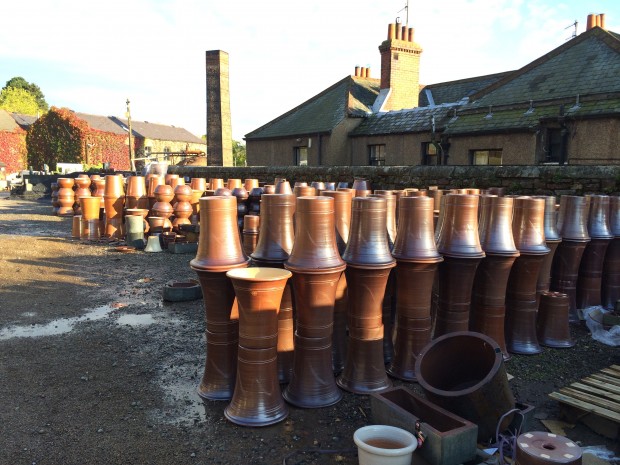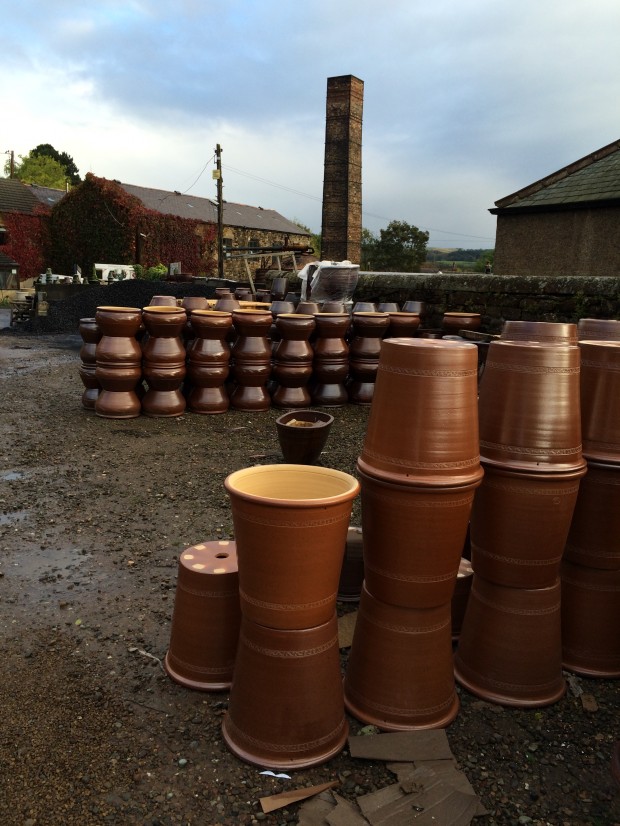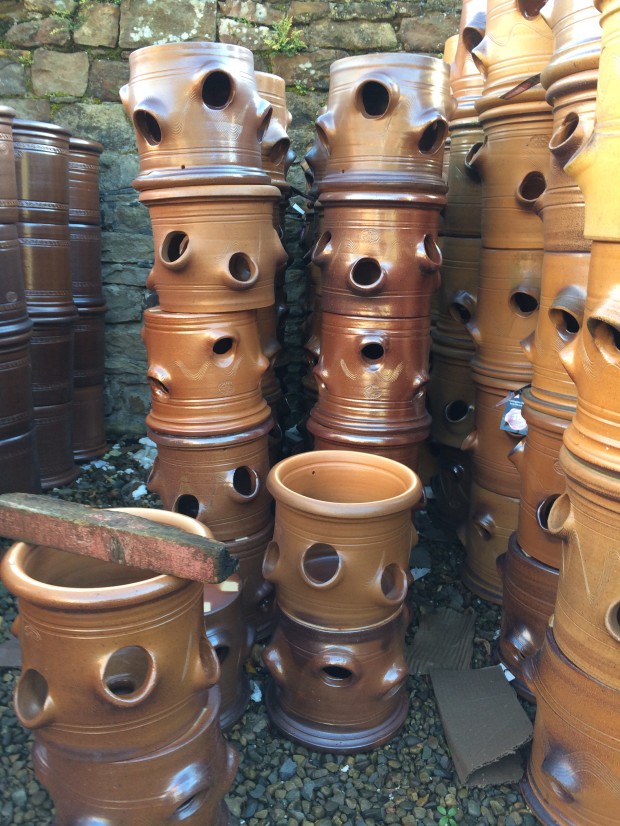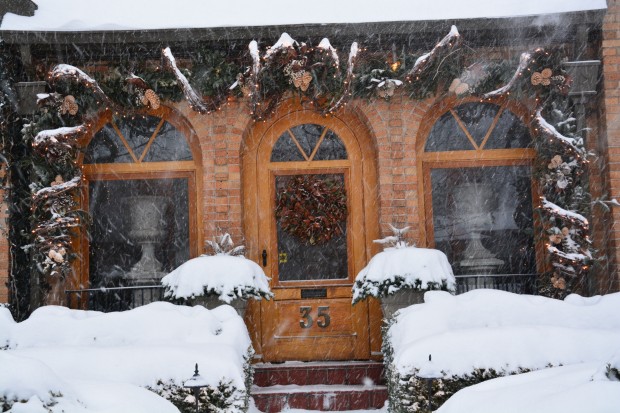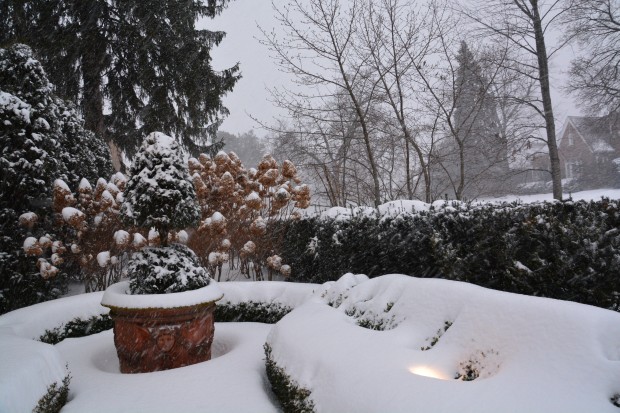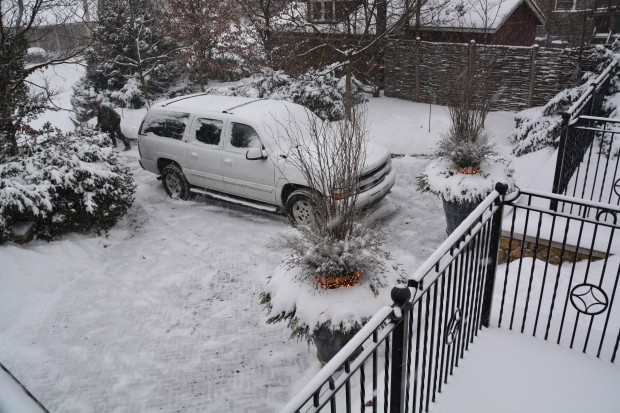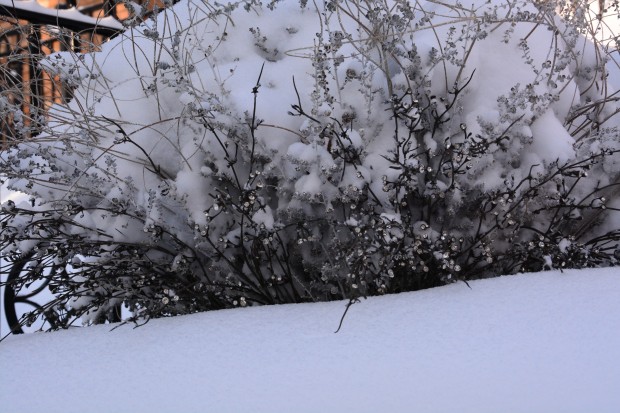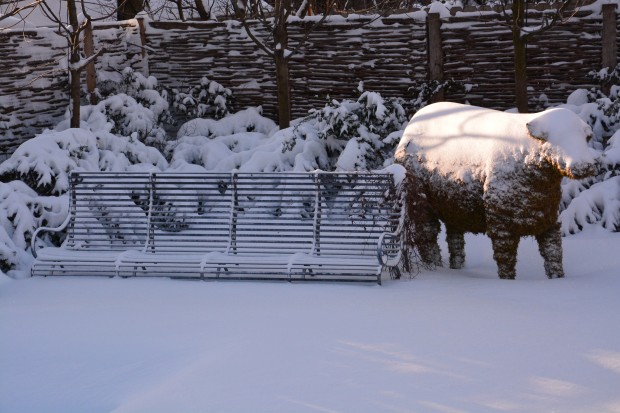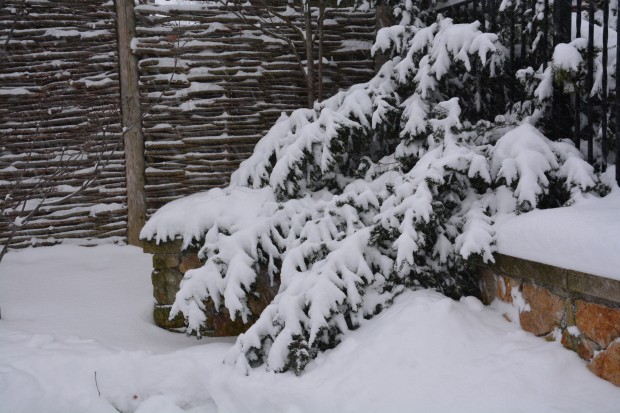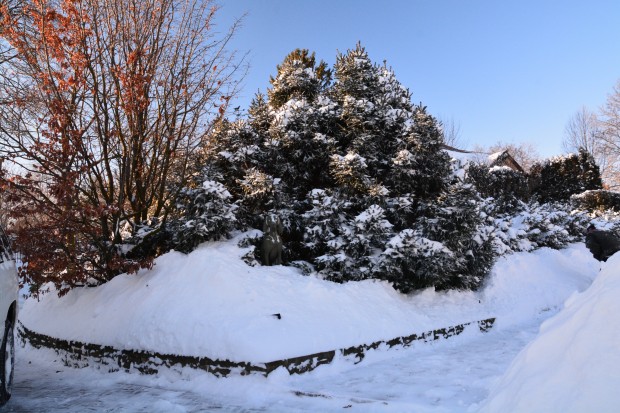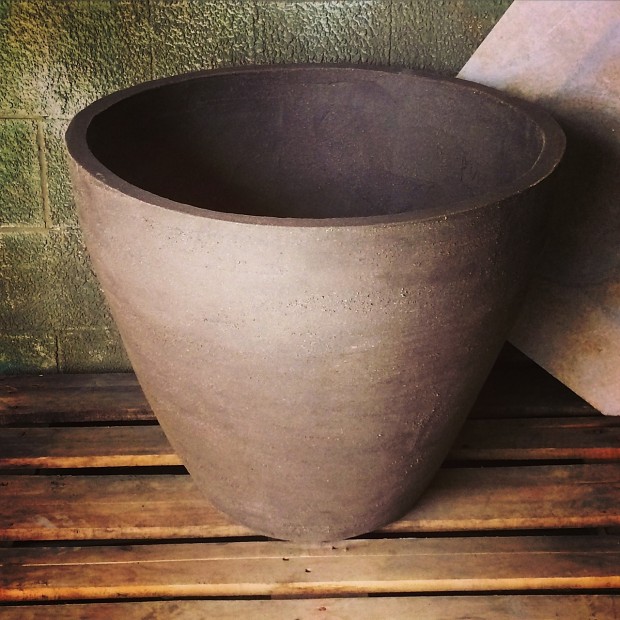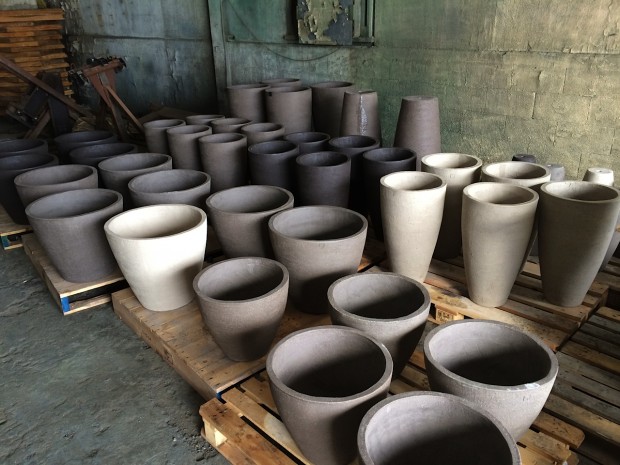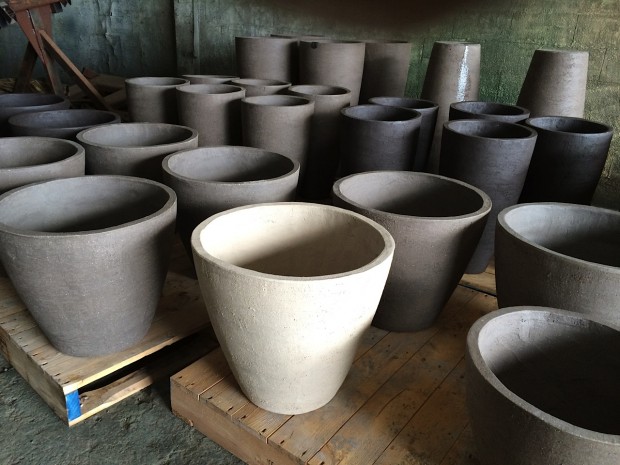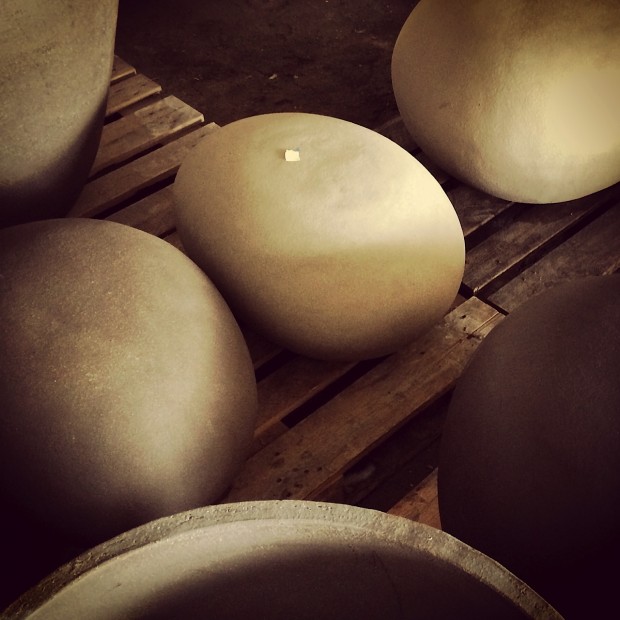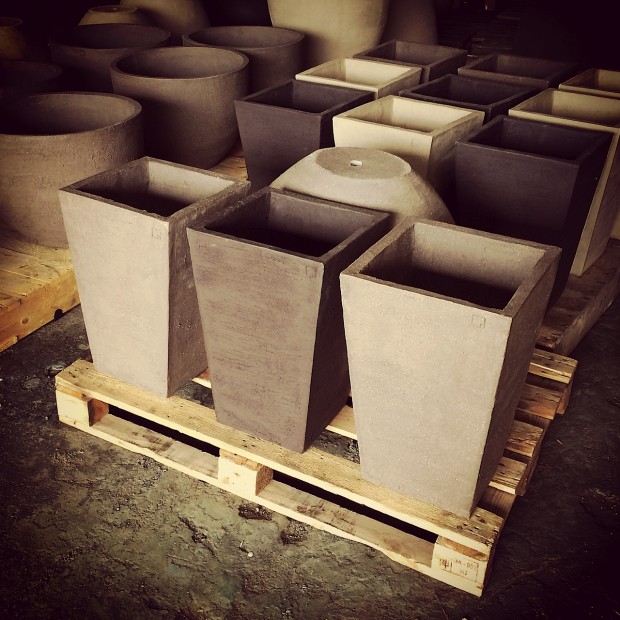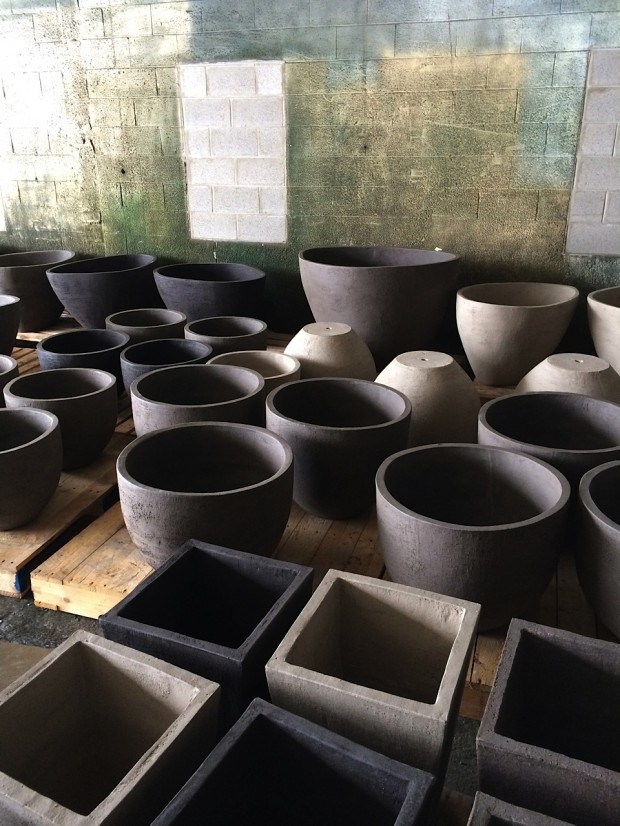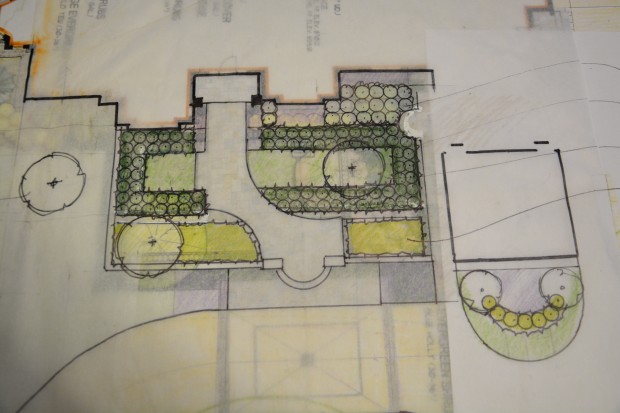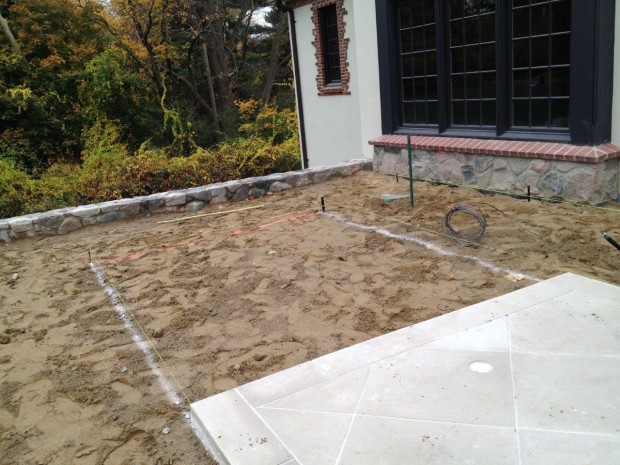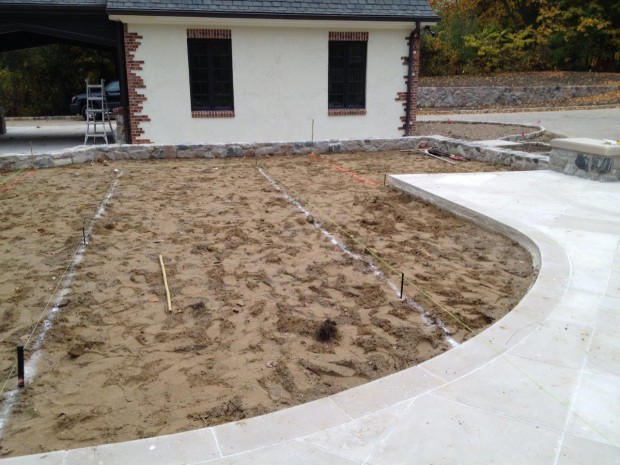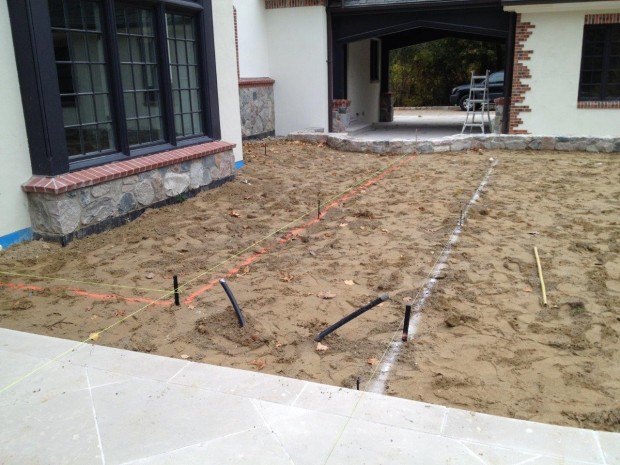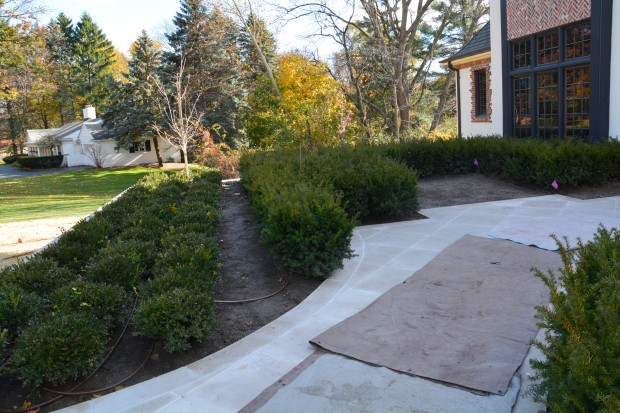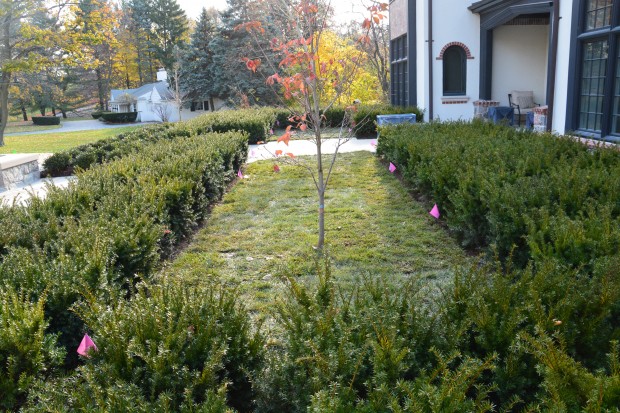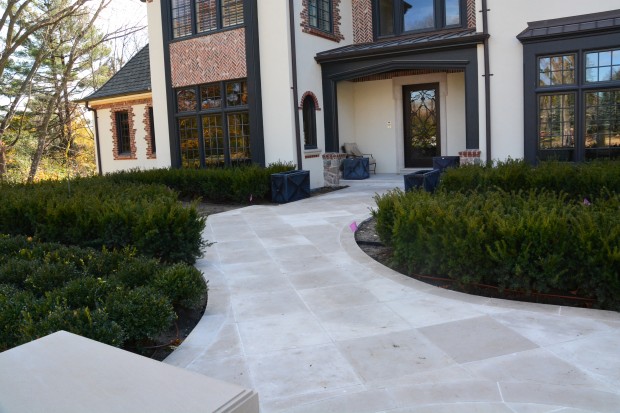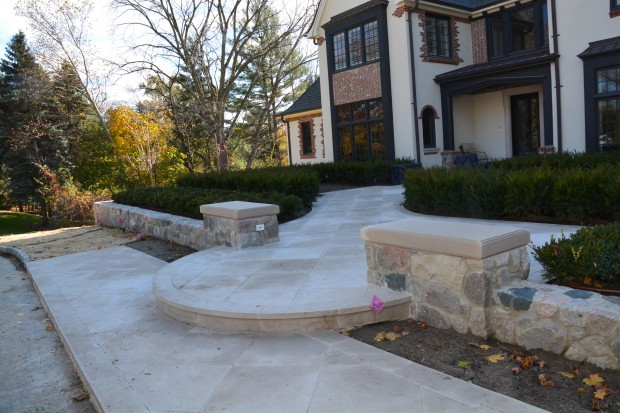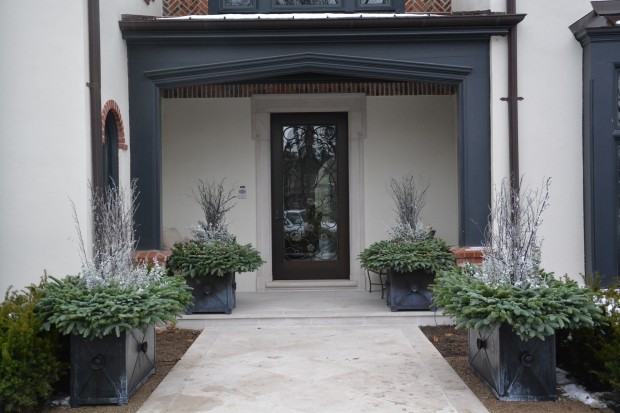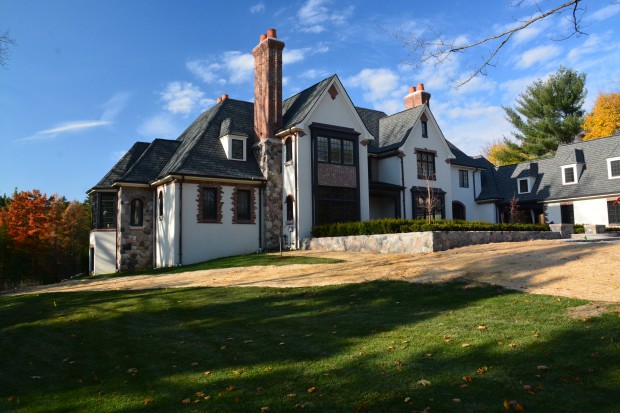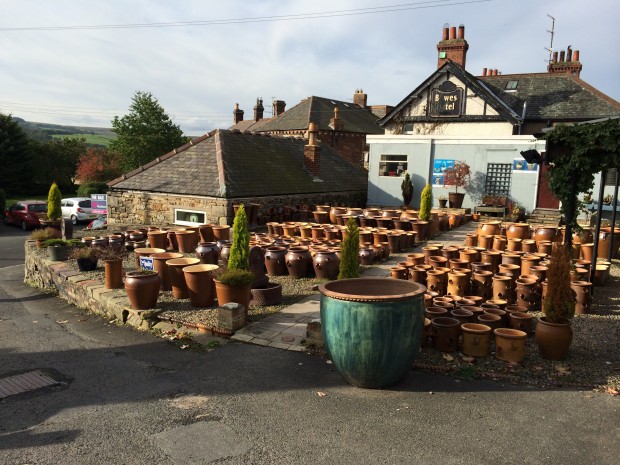 Anywhere in the world where garden pots are made, there are stoneware pots being made. As noted in the post on Belgian stoneware, the stone like quality of the pots has to do with the mineral content of the clay, which when fired at very high temperatures, becomes very hard, and impervious to frost. The English made stoneware pots pictured above have a particularly beautiful color and surface, which comes from a process known as salt glazing. From Wikipedia: “Salt glaze pottery is stoneware with a glaze of glossy, translucent and slightly orange-peel-like texture which was formed by throwing common salt into the kiln during the higher temperature part of the firing process. Sodium from the salt reacts with silica in the clay body to form a glassy coating of sodium silicate.” The glazed surfaces of these pots is definitely glassy. The color reminds me of freshly baked bread. Delicious. That glossy brown color is beautiful, in contrast to a treasured group of plants.
Anywhere in the world where garden pots are made, there are stoneware pots being made. As noted in the post on Belgian stoneware, the stone like quality of the pots has to do with the mineral content of the clay, which when fired at very high temperatures, becomes very hard, and impervious to frost. The English made stoneware pots pictured above have a particularly beautiful color and surface, which comes from a process known as salt glazing. From Wikipedia: “Salt glaze pottery is stoneware with a glaze of glossy, translucent and slightly orange-peel-like texture which was formed by throwing common salt into the kiln during the higher temperature part of the firing process. Sodium from the salt reacts with silica in the clay body to form a glassy coating of sodium silicate.” The glazed surfaces of these pots is definitely glassy. The color reminds me of freshly baked bread. Delicious. That glossy brown color is beautiful, in contrast to a treasured group of plants.
 The pottery has been in production since 1878. It has remained a family owned business throughout the past 237 years. Each pot is either hand thrown, molded, or cast. The people who make these pots are working people. Just like the gardeners I know. Rob toured the pottery last September, and placed a large order. Pictured above is his rental car in the pottery lot. That order was delivered to our shipper several weeks ago, and will hopefully be on its way to us shortly.
The pottery has been in production since 1878. It has remained a family owned business throughout the past 237 years. Each pot is either hand thrown, molded, or cast. The people who make these pots are working people. Just like the gardeners I know. Rob toured the pottery last September, and placed a large order. Pictured above is his rental car in the pottery lot. That order was delivered to our shipper several weeks ago, and will hopefully be on its way to us shortly.
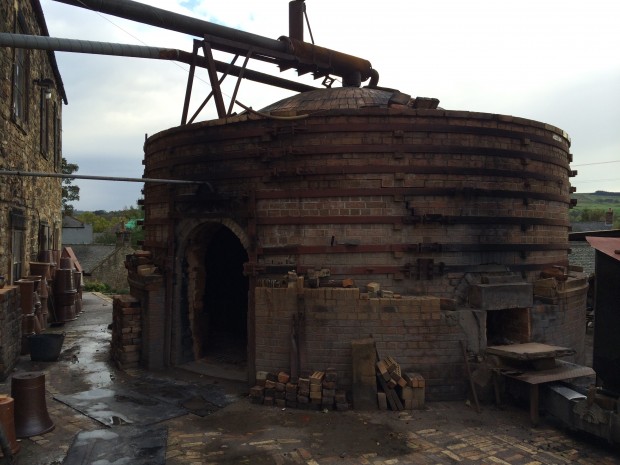 The beehive kiln is very old, but works well enough to thoroughly cook these iconic British pots. The heat from the kiln is recycled into the building where the pots are made, via that large pipe at the top. This ancient kiln is as beautiful as the pots.
The beehive kiln is very old, but works well enough to thoroughly cook these iconic British pots. The heat from the kiln is recycled into the building where the pots are made, via that large pipe at the top. This ancient kiln is as beautiful as the pots.
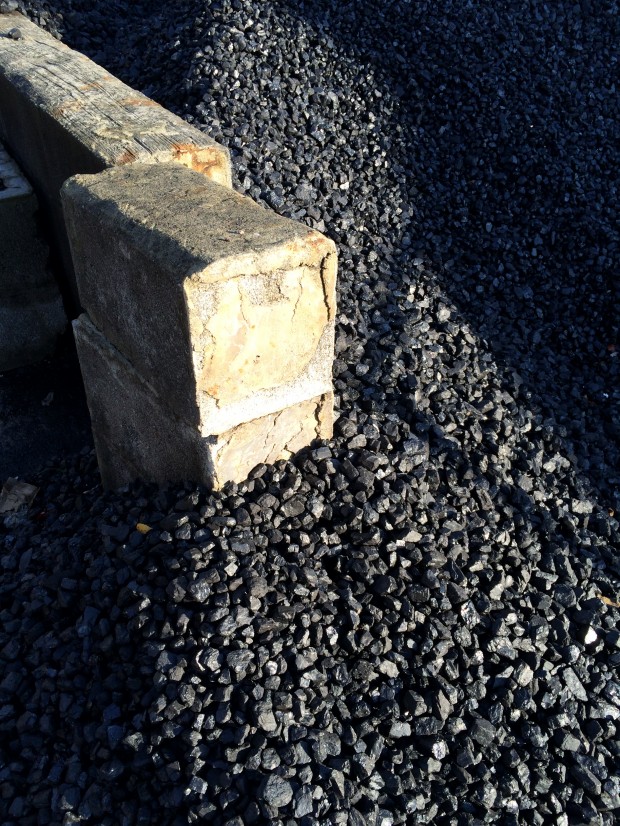 The kiln is coal fired, with a type of coal that is very hard and clean burning. Anthracite is very difficult to ignite, but once it is burning, it burns with a smokeless blue flame.
The kiln is coal fired, with a type of coal that is very hard and clean burning. Anthracite is very difficult to ignite, but once it is burning, it burns with a smokeless blue flame.
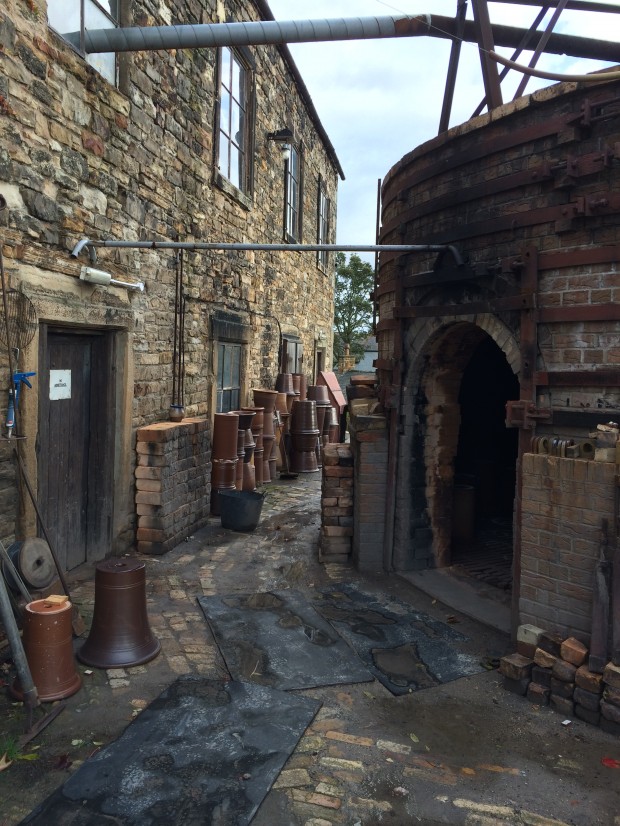 The temperature inside the kiln at the height of the firing cycle is incredibly hot. Handfuls of salt are thrown inside, at the hottest moment. This results in a lot of variation in color – but every color variation is beautiful. That heat keeps the adjacent studio warm. Though this kiln is ancient, the pots have a timeless quality to them. They are quiet and sturdy. We so value stoneware garden pots, as when they are properly cared for, they can survive our winters. At one time or another I have left all manner of handmade garden pots outside over the winter. The handmade pots have thick walls, and are fired at very high temperatures. This makes them a more durable pot all around. Stoneware pots are exceptionally durable. If you love terra cotta pots in your garden, consider a stoneware pot. They will grace your garden year after year, without complaint. The design of these pots is all about their functionality. The rims are thick, and resist chipping. The drain holes are generous. Even the small sizes have generous planting area.
The temperature inside the kiln at the height of the firing cycle is incredibly hot. Handfuls of salt are thrown inside, at the hottest moment. This results in a lot of variation in color – but every color variation is beautiful. That heat keeps the adjacent studio warm. Though this kiln is ancient, the pots have a timeless quality to them. They are quiet and sturdy. We so value stoneware garden pots, as when they are properly cared for, they can survive our winters. At one time or another I have left all manner of handmade garden pots outside over the winter. The handmade pots have thick walls, and are fired at very high temperatures. This makes them a more durable pot all around. Stoneware pots are exceptionally durable. If you love terra cotta pots in your garden, consider a stoneware pot. They will grace your garden year after year, without complaint. The design of these pots is all about their functionality. The rims are thick, and resist chipping. The drain holes are generous. Even the small sizes have generous planting area.
 The real beauty of these pots is the beauty that comes from within. They are made one at a time, all by hand. They have a history that dates back centuries. They are not fancy. They are handsome, and serviceable. The surface glows, and the colors are scrumptious. These pots do the work, of providing a quietly beautiful home for a collection of flowering plants, or a grouping of rosemaries. The first container load we purchased from them 2 years ago is gone now. It was time to restock. They are very different than the Belgian stoneware pots-but I would not hesitate to put them together. I would be confident to place them in a more contemporary setting as much as a more traditional garden. Their clean lines and simple shapes would work just about anywhere.
The real beauty of these pots is the beauty that comes from within. They are made one at a time, all by hand. They have a history that dates back centuries. They are not fancy. They are handsome, and serviceable. The surface glows, and the colors are scrumptious. These pots do the work, of providing a quietly beautiful home for a collection of flowering plants, or a grouping of rosemaries. The first container load we purchased from them 2 years ago is gone now. It was time to restock. They are very different than the Belgian stoneware pots-but I would not hesitate to put them together. I would be confident to place them in a more contemporary setting as much as a more traditional garden. Their clean lines and simple shapes would work just about anywhere.
 It took four months for our order to be made. One pot at a time. They are worth waiting for – of that I am sure. I have held them in my hands, and felt glad to be a gardener. Rob’s pictures of his visit to the pottery tells that story. Early in March, we will be awash in these pots. I can’t wait.
It took four months for our order to be made. One pot at a time. They are worth waiting for – of that I am sure. I have held them in my hands, and felt glad to be a gardener. Rob’s pictures of his visit to the pottery tells that story. Early in March, we will be awash in these pots. I can’t wait.
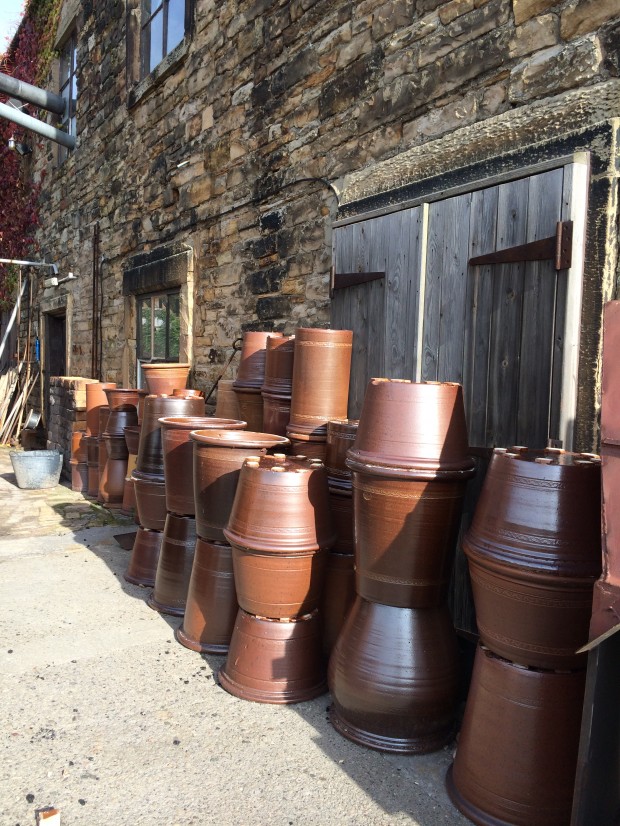 stacks of salt glazed pots
stacks of salt glazed pots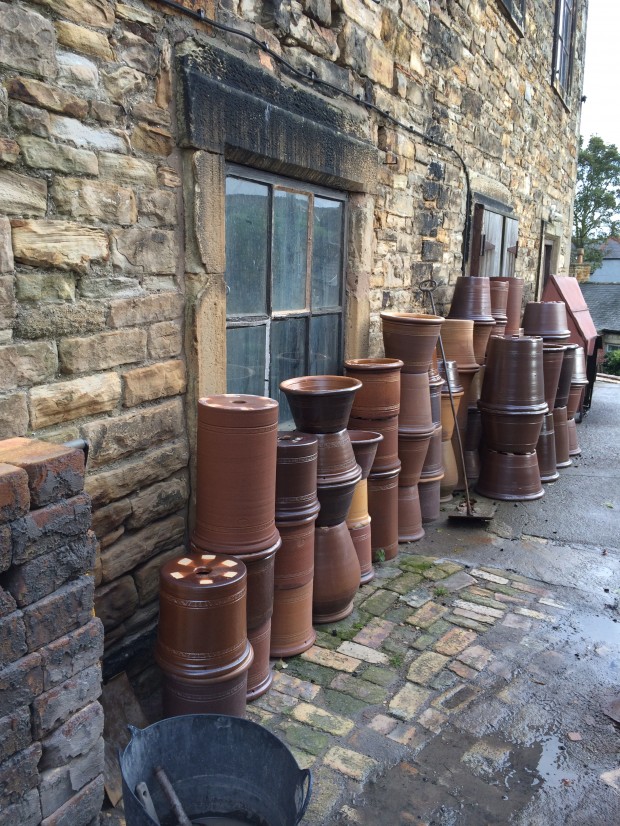 English salt glazed pots
English salt glazed pots
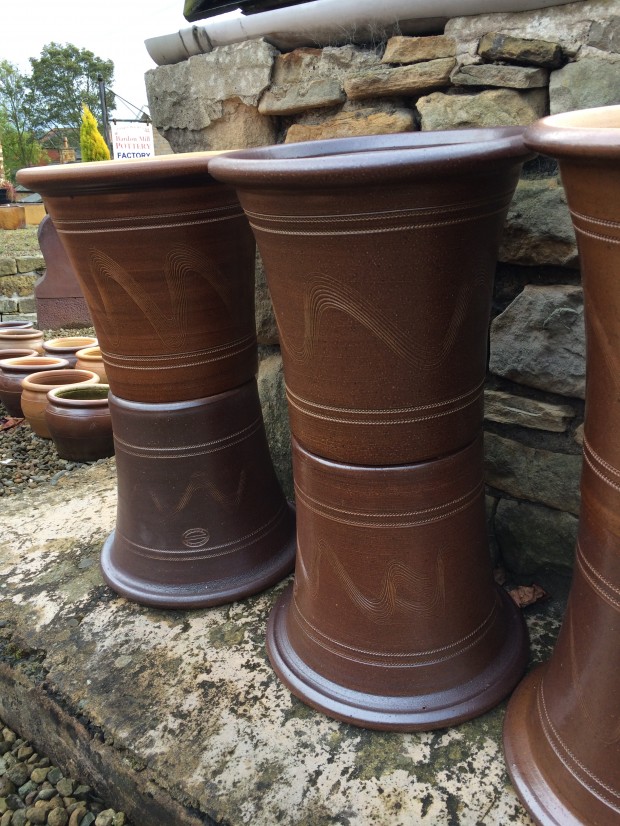 These pots may be subtle, but their story is remarkable. I am so looking forward to having them again.
These pots may be subtle, but their story is remarkable. I am so looking forward to having them again.

